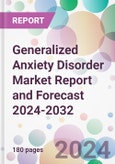Generalized Anxiety Disorder Market Outlook
The generalized anxiety disorder market size was valued at USD 1717.5 million in 2023, driven by growing recognition of generalized anxiety disorder as a serious mental health condition. The market size is anticipated to grow at a CAGR of 5.4% during the forecast period of 2024-2032 to achieve a value of USD 2751.1 million by 2032.Generalized Anxiety Disorder: Introduction
Generalized anxiety disorder (GAD) is a chronic mental health condition characterized by persistent and excessive worry about various aspects of daily life, often without a specific cause. Individuals with GAD find it difficult to control their anxiety, leading to symptoms such as restlessness, fatigue, difficulty concentrating, irritability, muscle tension, and sleep disturbances. GAD can significantly impair daily functioning and is often accompanied by other mood or anxiety disorders, necessitating professional evaluation and treatment.Key Trends in the Generalized Anxiety Disorder Market
Globally, there's a growing recognition of GAD as a serious mental health condition. Enhanced awareness among the public and healthcare professionals is leading to more frequent diagnosis and a higher reported prevalence.There's a trend towards personalized treatment plans, combining pharmacotherapy (like SSRIs and SNRIs) with psychotherapy (particularly Cognitive Behavioral Therapy). Research into new medication classes and therapy forms is ongoing, aiming to improve outcomes and reduce side effects.
The adoption of digital tools, including mobile apps for anxiety management and teletherapy services, is on the rise. These tools offer accessible and flexible treatment options, particularly important in regions with limited mental health resources.
There's a growing emphasis on holistic and integrated care approaches, combining mental health services with primary care to ensure comprehensive management of GAD, especially given its frequent comorbidity with other health conditions.
Various regions are witnessing increased governmental and non-governmental investment in mental health services, aiming to improve access to care and support mental health research.
Efforts to reduce stigma around mental health and promote mental wellbeing are contributing to a more open environment for discussing and treating GAD.
Generalized Anxiety Disorder Market Segmentation
Market Breakup by Therapeutic Type
- Antidepressant
- Buspirone
- Benzodiazepines
Market Breakup by Therapy Type
- Interpersonal Therapy
- Behavior Therapy
- Cognitive Behavioral Therapy
- Mindfulness Based Cognitive Therapy
Market Breakup by Diagnosis
- Deep Brain Stimulation
- Electroconvulsive Therapy
- Transcranial Magnetic
- Stimulation Vagus Nerve
Market Breakup by Region
- United States
- EU-4 and the United Kingdom
- Germany
- France
- Italy
- Spain
- United Kingdom
- Japan
Generalized Anxiety Disorder Market Overview
North America market is well-established, particularly in the U.S. and Canada, with a high awareness of mental health issues and a wide range of treatment options available, including medication, psychotherapy, and integrated care models. There's a growing focus on personalized medicine and digital health solutions like teletherapy.Europe shows a strong emphasis on healthcare provision and mental health services, with countries like the UK, Germany, and France leading in terms of GAD treatment and research. The region is known for its comprehensive healthcare systems that include mental health services and a growing acceptance of mental health issues.
Japan market is growing, driven by increasing awareness of mental health conditions and improvements in healthcare infrastructure. The region is investing in mental health services, though cultural stigmas around mental health can impact the willingness to seek treatment.
Generalized Anxiety Disorder Market: Competitor Landscape
The key features of the market report include patent analysis, grants analysis, clinical trials analysis, funding and investment analysis, partnerships, and collaborations analysis by the leading key players. The major companies in the market are as follows:- Eli Lilly and Company
- GlaxoSmithKline Pharmaceuticals Limited
- Pfizer, Inc.
- Abbott Laboratories
- Bristol-Myers Squibb
- Actavis Pharmaceutical Company
- F. Hoffmann-La Roche
- Sumitomo Dainippon Pharma
- MindMed
- VistaGen Therapeutics, Inc
- Mitsubishi Chemical Group Corporation
- Sanofi
- Mitsubishi Chemical Group Corporation
- Forest Laboratories, Inc
- H. Lundbeck A/S
This product will be delivered within 5-7 business days.
Table of Contents
1 Preface
3 Generalized Anxiety Disorder Overview
4 Patient Profile
5 Generalized Anxiety Disorder Epidemiology Analysis - 7MM
6 Generalized Anxiety Disorder Market Overview - 7MM
7 Generalized Anxiety Disorder Market Landscape - 7MM
8 Generalized Anxiety Disorder Challenges and Unmet Needs
10 Generalized Anxiety Disorder Market Dynamics
11 Generalized Anxiety Disorder Market Segmentation - 7MM
12 United States Generalized Anxiety Disorder Market
13 EU-4 and United Kingdom Generalized Anxiety Disorder Market
14 Japan Generalized Anxiety Disorder Market
15 Patent Analysis
16 Grants Analysis
17 Clinical Trials Analysis
18 Funding Analysis
19 Partnership and Collaborations Analysis
20 Supplier Landscape
21 Generalized Anxiety Disorder Market - Distribution Model (Additional Insight)
23 Company Competitiveness Analysis (Additional Insight)
24 Payment Methods (Additional Insight)
Companies Mentioned
- Eli Lilly and Company
- GlaxoSmithKline Pharmaceuticals Limited
- Pfizer Inc.
- Abbott Laboratories
- Bristol-Myers Squibb
- Actavis Pharmaceutical Company
- F. Hoffmann-La Roche
- Sumitomo Dainippon Pharma
- MindMed
- VistaGen Therapeutics Inc
- Mitsubishi Chemical Group Corporation
- Sanofi
- Mitsubishi Chemical Group Corporation
- Forest Laboratories Inc
- H. Lundbeck A/S
Methodology

LOADING...
Table Information
| Report Attribute | Details |
|---|---|
| No. of Pages | 180 |
| Published | February 2024 |
| Forecast Period | 2024 - 2032 |
| Estimated Market Value ( USD | $ 1.81 Billion |
| Forecasted Market Value ( USD | $ 2.75 Billion |
| Compound Annual Growth Rate | 5.4% |
| Regions Covered | Global |
| No. of Companies Mentioned | 15 |









